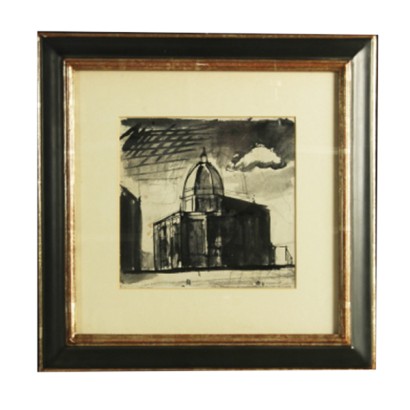Mario Sironi (1885-1961) - Cathedral
Features
Artist: Mario Sironi (1885-1961)
Age: Contemporary
Description
Diluted tempera, ink and pencil traces on cardboard. At the back pencil sketch of 'Figure'. Art work archived by the Association for the patronage and promotion of the figure and work of Mario Sironi. Attached technical sheet. Presented in frame with glass.
Frame Size (cm):
Height: 40
Width: 40
Artwork dimensions (cm):
Height: 20
Width: 20
Depth: 5
With certificate of authenticity
Additional Information
Artist: Mario Sironi (1885-1961)
Born in Sassari on May 12, 1885, Mario Sironi completed his training in Rome, where the family had moved the year after his birth, so much so that he "considered himself more than anything else a Roman, and he also had a Roman accent". His adolescence was marked not only by the suggestions of the Eternal City, but also by passionate readings (Schopenhauer, Nietzsche, Heine, Leopardi, the French novelists) and by the study of music, above all by Wagner, who he played on the piano with his older sister Cristina, future concert artist. In 1902 he enrolled in the engineering faculty, but the following year he was struck by a depressive crisis, the first symptom of the existential malaise that would accompany him throughout his life. Having therefore abandoned university and encouraged by the positive judgment of the old sculptor Ximenes and the pointillist Discovolo, Sironi devoted himself to painting, attending the Scuola Libera del Nudo in via Ripetta and Balla's studio. Here he meets Boccioni (who, despite some moments of misunderstanding, becomes the closest friend of his youth), Severini and other artists. He also began to perform illustrations, drawing three covers for "L'Avanti della Domenica" and, in 1905, he participated in an exhibition for the first time. In the same period Sironi began to undertake his first trips: in 1906 to Paris, where Boccioni was also at the time; in 1908 in Erfurt, Germany, where he also returned in 1910-1911, as a guest of the sculptor Tannenbaum. Boccioni's diaries and letters inform us of Sironi's recurrent depressive crises, which led him to shut himself up at home, seeing no one, concentrating obsessively on drawing. But they also reveal his deep love for the classics, just as the futurist manifestos call for the destruction of museums. Starting in 1913, inspired by the work of Boccioni, he approached futurism, which he however interpreted in the light of his incessant volumetric research. In 1915 he moved briefly to Milan, where he collaborated with the magazine "Gli Avvenimenti" and entered the core of futurism. At the outbreak of war he enlisted in the Cyclist Volunteer Battalion, which also included Boccioni, Marinetti, Sant'Elia, Funi, Russolo, and in December he signed the Futurist manifesto L'orgoglio italiano. He was at the forefront until 1918, when he was moved to the Propaganda Office, where he collaborated with Bontempelli on the trench magazine "Il Montello". Returning to Rome in 1919, he participated in the Great National Futurist Exhibition, exhibiting fifteen works mainly on the theme of war. By now, however, metaphysical suggestions borrowed from Carlo Carrà and Giorgio De Chirico pervade his painting. In January 1920, with Achille Funi, Leonardo Dudreville and Luigi Russolo, Sironi signed the Futurist manifesto Against all returns to painting, which despite its title already contains many instances of the future Novecento Italiano. In addition to painting, Sironi continued to devote himself to drawing and illustration: from 1922 to 25 July 1943 he was the main illustrator of Il Popolo d'Italia, Benito Mussolini's newspaper on which from 1922 to 1926 he made very heavy caricatures of the anti-fascists of the time. In December 1922 he founded with Anselmo Bucci, Gian Emilio Malerba, Pietro Marussig, Ubaldo Oppi and again with Dudreville and Funi, the Novecento Italiano, the movement aspiring to a "modern classicism", that is to say a classical form, devoid of nineteenth-century pictorialisms, filtered through a purist synthesis. In 1924 Sironi participated in the Venice Biennale with the Novecento group. Around the 1930s his painting abandoned the clear sign of the first twentieth-century season and went through an expressionist period, characterized by an approximation of the figure and by a violence of the brushstroke that disoriented most of the critics. Over the following decade he devoted himself more and more to large decoration, neglecting the easel picture, which he now considered an insufficient form. Mural painting, for him, was not just a technique, but a radically different way, ancient and classic, but also new and fascist, because, as he himself stated, "social par excellence" of thinking about art. The whole decade saw him engaged in a series of monumental works, in which, having overcome the expressionist sprezzature, he adopted a multicentric composition, often in squares, governed by a pre-Renaissance spatiality and perspective. In September 1943 Sironi joined the Republic of Salò, following the evolution of events with growing anguish. On 25 April he also risked being shot: stopped at a checkpoint in Milan by a partisan brigade, he would have been killed if Gianni Rodari, who was part of the brigade and had recognized him, hadn't signed a pass for him. However, he did not stop working, but in the last few years, he polemically refused to participate in the Venice Biennials, while continuing to exhibit in Italy (Milan Triennale, 1951; Rome Quadrennial, 1955) and abroad (travelling exhibition in the United States , with Marino Marini, in 1953). He also made sets and costumes for various theatres. In the meantime, his health deteriorated, also due to the onset of progressive arthritis and he died in Milan on August 13, 1961, following a bronchopneumonia.
Age: Contemporary
Contemporary 






















